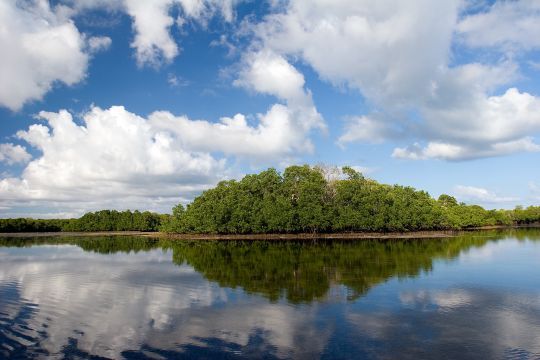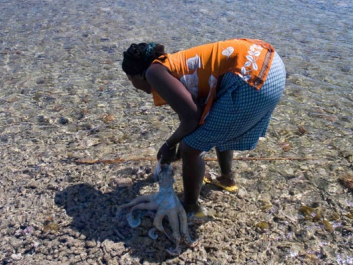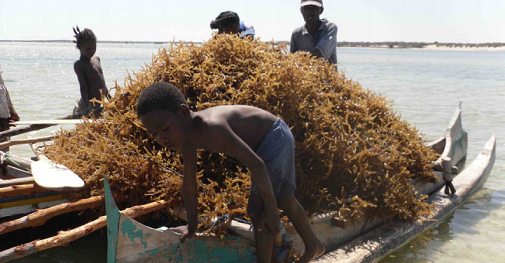Livelihoods and Population, Health and Environment (PHE) in the Velondriake Locally Managed Marine Area – Madagascar


Building Actors and Leaders for Advancing Community Excellence in Development (BALANCED) Newsletter
(Volume 1 | Issue 3 | June 2011)
Along the southwest coast of Madagascar lies the world’s fourth largest reef system with some of the most extensive and biodiverse marine and coastal ecosystems of the Western Indian Ocean. This coast is also home to many isolated communities of the semi-nomadic, sea-faring Vezo people. Blue Ventures has been working in this area since 2003 to conserve these important natural resources and to help ensure the continuation of the marine based Vezo lifestyle.
Blue Ventures’ integrated population-health-environment (PHE) programs are addressing livelihood needs by encouraging long term sustainability of fish stocks, supporting alternative income sources, and helping to increase overall family well-being including through the promotion of family planning—all crucial efforts in communities that are heavily dependent on natural resources and where population pressures on those resources are high. Blue Ventures’ programs are funded by its own ecotourism programs, as well as through generous funding from the John D. and Catherine T. MacArthur Foundation, PROGECO, NorgesVel, and the United Nations Population Fund.

Octupus Harvest. Photo by Gareth Cripps.
Integrating Programming
With nearly all households relying almost entirely on the direct use of coastal and marine resources for their livelihoods, a sustainable harvest from reef fisheries and other key habitats such as mangroves is crucial to safeguarding these communities’ future (Epps 2007). Yet, a combination of destructive fishing practices, local and commercial over-exploitation, hypersedimentation, and climate change has negatively affected the health of the local marine and coastal ecosystems. In response to these locally observed changes, Blue Ventures helped 24 communities join forces to develop a locally managed marine area (LMMA) called Velondriake (‘to live with the sea’ in the local Vezo dialect). Encompassing all 24 villages, this LMMA restricts destructive fishing practices such as beach seine netting and poison fishing and includes seasonal and permanent coral reef and mangrove reserves, which contribute to restoration and conservation of marine and coastal health. These actions are critical to local livelihoods and food security and are essential to helping mitigate future anthropogenic and climatic pressures.
One of the most effective management approaches pioneered in Velondriake has been the use of temporary three to four month closures of shallow reef flats to octopus fishing, which is the most economically important fishery in this region. These seasonal restrictions allow the target species (Octopus cyanea) to increase rapidly in size and number. Fisheries research conducted by Blue Ventures over the last seven years has shown that villages that observe these closures see a significant increase in total landings after the reserve is re-opened, see no significant change in landings while the closure is in effect, and see lasting economic and social benefits to communities (Oliver, T. pers comm.). These successful results have inspired extensive replication of similar octopus closures along the coasts both north and south of Velondriake, with well over 100 closures to date across hundreds of kilometres of coastline.
In addition to the long-term conservation of fisheries, a key component of Blue Ventures’ work in Velondriake is a sustainable aquaculture program that works with community groups and families to farm seaweed (Kappaphycus alvarezii) and grow sea cucumbers (Holothuria scabra) for international export. Once abundant in the wild, sea cucumber numbers have dropped dramatically in the last decade as a result of unsustainable overharvesting driven by the high price these animals fetch on the international market. Southwest Madagascar’s extensive seagrass lagoons provide an ideal spot for raising sea cucumbers, and the nearby city of Toliara is home to one of the only commercial hatcheries in the world, as well as a local seafood export company working with Blue Ventures to ensure the purchase of market-ready adults.
With Blue Ventures’ technical support, sea cucumbers are reared in the intertidal zone of several villages, one of the first attempts worldwide to raise these ecologically important animals in enclosures within their natural habitat. Research pens are being used to experiment with new designs of both pens and nets, to better understand the ideal size of juveniles for release from hatchery to pen, and to determine the optimum stocking density within each pen. Improvements in all these areas since the first ‘holothuriculture’ trials in 2007 have greatly increased survival rates, with the mortality rate of sea cucumbers dropping from approximately 90 percent to 30 percent (and less than 10 percent in the research pens). This highly significant decrease makes rearing much more profitable for local families and provides a clear economic incentive to communities to take up this ecologically beneficial form of aquaculture.
Similarly, seaweed is grown on lines in shallow intertidal zones off the coasts of several villages within Velondriake. The crop is harvested after six weeks, dried, and sold to the export company. Unlike sea cucumbers, the process of raising seaweed is well understood throughout the world, and therefore technical support and problem-solving is much more straightforward.
Diversifying coastal sources of income through aquaculture helps reduce pressure on overexploited coral reefs, improving ecological sustainability within the LMMA and helping wild stocks of over-exploited sea cucumbers to recover. Sustainable aquaculture also contributes to local economic development, helping families supplement traditional household income and reduce the number of people solely reliant on daily fishing.
Anthropogenic pressures on the region’s marine and coastal resources are growing due to changes in fishing methods and an increase in the number of people dependent on these resources. Immigration from inland villages to the coast, often following crop failure, is common in this arid region, as is immigration along the coast from the north and south as fish stocks in adjacent areas diminish. In addition, with an average of 6.7 children per woman, the local population of Velondriake is growing at a rate that is likely to outpace the recovery rates of fisheries stocks and the region’s ability to generate alternative livelihoods (Blue Ventures, unpublished data). Therefore, the third component of Blue Ventures’ integrated approach is a family planning and community health program, which provides family planning and reproductive health services to the Velondriake villages, allowing them to choose when and how many children to have. Not only do smaller, healthier families reduce the growing pressure on the area’s fragile natural resources, but practicing family planning and improving household sanitation can also increase family well-being. For example, mothers have more time to contribute to activities that will help generate household income and are less physically burdened by multiple, closely-spaced births. Likewise, families with well-spaced, healthy children can often save more money and ensure that all children have adequate nutrition, clothing, and fees for school. As a result of Blue Ventures community-based family planning interventions, contraceptive prevalence rate increased from 8.3 % to 42% and from 10.7% to 27% in Andavadoaka and Velondriake respectively.
Challenges
Many of Blue Ventures’ challenges in PHE stem from working in such a remote and isolated area—Velondriake is accessible from the rest of Madagascar only via dirt or sand roads, which are often impassable after heavy rains, and even in favourable conditions require at least eight hours in a strong 4×4 vehicle to reach the nearest town. This makes bringing supplies (for example netting,ropes and family planning supplies) difficult and expensive. Likewise, transportation to the villages within Velondriake—many of which are located on islands or within isolated mangrove forests—is difficult; program staff are often reliant on traditional sailing pirogues and at the mercy of the wind and weather, and it can take two to three days to travel between some villages within the LMMA.
Another challenge is that of working primarily with individuals who have little or no formal education and of identifying local individuals to partner with who are motivated and capable. Investments in building the capacity of Velondriake committee members, aquaculturists, and community-based distributors of family planning and community health products are ongoing.
A third challenge, and one which many other PHE organizations and projects are likely to experience, is how best to foster genuine integration between the three segments/sectors of population, health, and environment. With separate funding streams, differing programmatic start dates, and staff who may have initially been hired for a specific activity of an otherwise multidisciplinary initiative, it is often a challenge to break from thinking and acting with only one’s primary program objectives in mind. Blue Ventures is addressing this challenge by making sure to conduct frequent cross-program meetings and training sessions on how the programs integrate and are interdependent. Staff is also working to find a balance between having staff with specific technical/programmatic skills that are needed, while also encouraging them to be mutually supportive generalists.
Finally, and specific to the alternative livelihoods program, there is a great desire on the part of the local communities to begin seaweed farming or sea cucumber rearing and yet successful implementation is limited by physical geography. Both seaweed farming and sea cucumber rearing require gradually sloping intertidal zones that are protected by strong winds and waves during bad weather. Additionally, seaweed thrives in areas with constant water flow whereas sea cucumbers require different underlying sediments with sufficient nutrient-rich detritus on the sea floor. So, while broad-scale expansion of these alternative livelihood initiatives within all coastal villages is a frequent request from partner communities, such scaling is simply not feasible with current technology.

Seaweed Harvest. Photo by Kame Westerman/Blue Ventures.
Lessons Learnt
There are several key reasons why Blue Ventures has been successful in all three of its programs—marine resource management, alternative livelihoods, and family planning. First is the organization’s relatively small geographic focus. While far-reaching, broad-scale conservation and development can only be achieved at large levels, scaling-up from a successful pilot too quickly can be dangerous and costly. Through its work in Velondriake over the last eight years, Blue Ventures has prioritized these 24 villages and the coastal and marine environment in which they lie in order to understand what works well in this context.
Likewise, Blue Ventures has paid great attention to successes and challenges over time, and has made it a priority to understand how and why challenges exist. Patient to get things right, it was not until late 2009 that Blue Ventures looked towards replicating the marine management successes seen here in Velondriake to a second site further north. Similarly, the family planning and community health program is now expanding outside Velondriake villages, but again, only after several years of close observation. Likewise, the expansion of sea cucumbers and seaweed to other villages will happen only after the model has been refined to a truly replicable form, and Blue Ventures is confident that the habitat is suitable and that the factors contributing to early mortality can be adequately controlled.
Because the community-based sea cucumber rearing project is currently globally unique, Blue Ventures technicians have found it particularly useful to organize frequent meetings in order to discuss challenges, successes, and lessons learned with partners. These meetings include a variety of players—local government authorities, private fisheries export and collection companies, funders, researchers and NGOs—and have served to encourage critical information exchanges and to foster cooperation and synergy between the numerous sectors engaged in Blue Ventures’ work.
Importantly, Blue Ventures is invested in the communities of Velondriake and these programs for the long term. Because the organization receives funding from the social enterprise side, there is a vested interest in and ability to continue work in the region even if outside funding declines or disappears. With nearly a decade of presence in this area, and plans to support these communities in the future, Blue Ventures can be assured that—when the time does come to leave—that continued efforts here are program-driven, not donor-driven.
Finally, much of Blue Ventures’ success in community-based marine conservation may also be attributed to the organization’s early focus on octopus fisheries management, which enabled communities to see first-hand (and, importantly, over a short time frame of three to six months) the fisheries and economic benefits of closures. These early successes helped local people to understand that management actions can have a positive effect on their own bottom line as well as the environment and that they are in a position to alter the future of their marine resources. This paved the way towards community support for the permanent coral reef and mangrove reserves. This idea of octopus closures to get the conservation ball rolling has inspired Blue Ventures, at a different conservation site in western Madagascar, to begin management efforts by piloting temporary crab closures in mangrove forests—again, with the hope that other, more ambitious and longer-term conservation initiatives will follow once communities feel empowered by these initial demonstrations.
References
Epps, M. 2007. A Socioeconomic Baseline Assessment: Implementing the socioeconomic monitoring guidelines in southwest Madagascar. Blue Ventures Conservation Report. Madagascar: Blue Ventures.
(0) Comments
There is no content